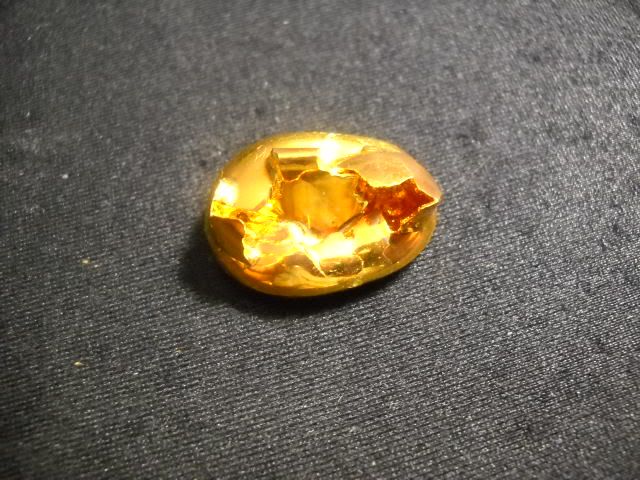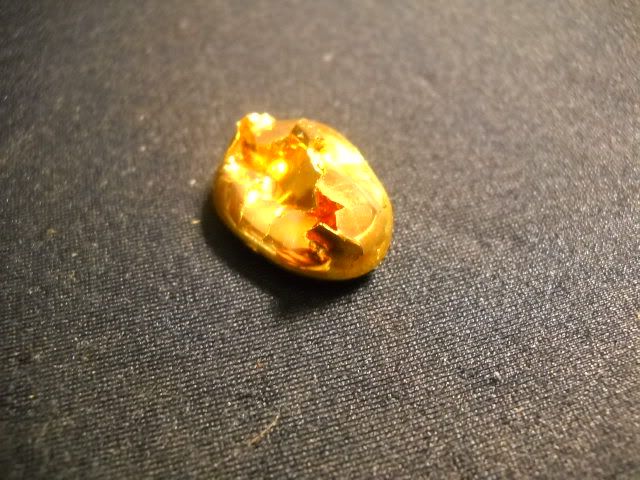Hi all!
It's been a long journey to get to this point... I'm sitting and playing with my 52 g gold button. 8)
It started so many years ago, long before I found GRF, almost 30 years ago. I was a teenager and scrapped relays and switches for silver when I discovered something golden in a TV. It was also the time when a schoolkid could buy acids in the nearest paint shop. Soon after I had some nice golden foils and water in a small flask.
Fast forward 25 years. I still got the bug, collecting both silver and gold scrap. processing fingers with nitric and melting into quite dirty gold. I had some ideas about how to refine it but I hadn't put any plan into work, and it was a good thing. Because in 2007 I discovered GRF and joined as member #1059. GRF wasn't as big then as it is today but there were already a lot of information. Not soon after I got my first brown powder of refined gold in an erlenmeyer flask and I was all :mrgreen:
Since then I have learned a lot, tested different techniques and materials. Sometimes made a mistake but always recovered. Every time adding to my pot in the flask, gram by gram. At first I told myself that I would stop at an ounce, but when I got there I had several batches going so I just continued. Finally this summer I felt ready to re-refine my gold and make that big button.
I started with 53.9g gold, calculated the amount of acid I needed for approximately 4:1 ratio ( 205 ml HCl and 51.2 ml HNO3), then measured up even more HCl (125 ml) as it doesn't hurt and 25 ml HNO3, thinking half a batch of acids is a safe starting point. After a while and some heating the reaction seemed to come to a stop. I poured off the auric chloride via a filter into a flask. Realizing that almost all gold had been dissolved I only added a bit of HCl and only 3 ml HNO3 and it was enough. 54g gold took only 150 ml HCl and 28 ml HNO3! 8)
Two months ago I brought the gold chloride, beakers, SMB, some sulphuric acid and filters to my parents, showing them how to drop the gold from solution to metallic powder.
The powder I brought back home for final wash (HCL, ammonia and water, never saw any discoloration of the washing liquids) and drying.
I went to my parents over the holidays and I brought the gold, a beaker from Steve and some borax and finally on Christmas day I melted the gold while my dad watched. We managed to melt it using only LPG and air but it took a while.
Sadly, there seemed to be some scrap falling off the fire bricks when melting since I got a bit of discoloration of the borax in one spot and a slight oxide discoloration of the gold button.
I guess I'll re-refine it again when I got another 50g of gold to add to it.
So... here are the pictures from start to finish. Ok, I start with the button. 8)
52.5 g final button. My red gold 18k ring looks like copper in comparision.

This is where I started, 53.9 g gold powder dropped with SMB.

Dissolving gold in aqua regia.

HAuCl4 250g/liter. I just love that orange color!

Dropped a second time and dried.

Continued below...
It's been a long journey to get to this point... I'm sitting and playing with my 52 g gold button. 8)
It started so many years ago, long before I found GRF, almost 30 years ago. I was a teenager and scrapped relays and switches for silver when I discovered something golden in a TV. It was also the time when a schoolkid could buy acids in the nearest paint shop. Soon after I had some nice golden foils and water in a small flask.
Fast forward 25 years. I still got the bug, collecting both silver and gold scrap. processing fingers with nitric and melting into quite dirty gold. I had some ideas about how to refine it but I hadn't put any plan into work, and it was a good thing. Because in 2007 I discovered GRF and joined as member #1059. GRF wasn't as big then as it is today but there were already a lot of information. Not soon after I got my first brown powder of refined gold in an erlenmeyer flask and I was all :mrgreen:
Since then I have learned a lot, tested different techniques and materials. Sometimes made a mistake but always recovered. Every time adding to my pot in the flask, gram by gram. At first I told myself that I would stop at an ounce, but when I got there I had several batches going so I just continued. Finally this summer I felt ready to re-refine my gold and make that big button.
I started with 53.9g gold, calculated the amount of acid I needed for approximately 4:1 ratio ( 205 ml HCl and 51.2 ml HNO3), then measured up even more HCl (125 ml) as it doesn't hurt and 25 ml HNO3, thinking half a batch of acids is a safe starting point. After a while and some heating the reaction seemed to come to a stop. I poured off the auric chloride via a filter into a flask. Realizing that almost all gold had been dissolved I only added a bit of HCl and only 3 ml HNO3 and it was enough. 54g gold took only 150 ml HCl and 28 ml HNO3! 8)
Two months ago I brought the gold chloride, beakers, SMB, some sulphuric acid and filters to my parents, showing them how to drop the gold from solution to metallic powder.
The powder I brought back home for final wash (HCL, ammonia and water, never saw any discoloration of the washing liquids) and drying.
I went to my parents over the holidays and I brought the gold, a beaker from Steve and some borax and finally on Christmas day I melted the gold while my dad watched. We managed to melt it using only LPG and air but it took a while.
Sadly, there seemed to be some scrap falling off the fire bricks when melting since I got a bit of discoloration of the borax in one spot and a slight oxide discoloration of the gold button.
I guess I'll re-refine it again when I got another 50g of gold to add to it.
So... here are the pictures from start to finish. Ok, I start with the button. 8)
52.5 g final button. My red gold 18k ring looks like copper in comparision.

This is where I started, 53.9 g gold powder dropped with SMB.

Dissolving gold in aqua regia.

HAuCl4 250g/liter. I just love that orange color!

Dropped a second time and dried.

Continued below...














